"Fifty years ago, in October 1973, Arab members of the Organization of the Petroleum Exporting Countries (OPEC) cut off oil shipments to the U.S. in retaliation for American support of Israel during the 1973 Arab-Israeli War," writes Jason Bordoff and Megan O'Sullivan in the October 7 2023 Wall Street Journal.
"The resulting energy crisis shocked the American people and rocked the economy. Iconic images of boxy sedans and wood-paneled station wagons lined up for miles at the gas pump were seared into national memory. Even the White House Christmas tree was not spared, remaining unlit as a sign of austerity."
Elsewhere in the article, the authors reported that "true energy security comes from using less oil, not just importing less or producing more oil domestically."
This month’s installment of YOUR NO-TILL HISTORY examines how no-till stepped out of the shadows during the two oil crises of the 1970s. While the process was born in Kentucky, American farm traditions die hard, and adoption was meager at best on the home front in the first 15 years.
But farmers in countries with less stable economies and without government assistance – like Brazil – found that no-till held the keys to survival.
The impact of no-till and fuel is told well through the story of No-Till Legend and South American no-till pioneer Herbert Bartz, who died in 2021 just shy of seeing the practice hit the half-century mark in Brazil. He is considered the father of no-till in the southern hemisphere.
Below is an excerpt of a chapter from the new Kindle Book, The Legacy of Herbert Bartz: the No-Tillage Pioneer, written by Wilhan Santin, with Rafael Silvaro, Marie Luise Carolina Bartz, Johann Bartz, Donald Reicosky, Dirceu Gassen, Jônadan Ma and Heidrun Kronenberg. This book was featured in the YOUR NO-TILL HISTORY article in the April 2023 issue of No-Till Farmer, “Latin America Becomes Global Power via No-Till” examined the “Crazy Germans” (Bartz and researcher Rolf Derpsch) who ushered no-till into Latin America where it’s practiced on 70% of acres today.
Throughout the region of Brazil’s Northern Paraná area, slowly some farmers showed at least some curiosity about how no-till worked. The researchers were also curious.
In 1973, researcher Rolf Derpsch went to the U.S. to attend a conference on no-till. He talked to Shirley Phillips and Harry Young Jr., who signed his copy of No-Tillage Farming, the seminal no-till book that Derpsch relied on to learn about the practice.
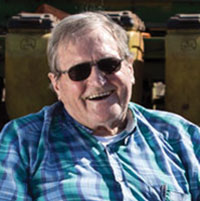
Herbert Bartz
In October of the previous year, at the same time as Herbert Bartz’s pioneering no-till planting in Brazil, Derpsch accompanied Glover Triplett Jr., from the Ohio Agricultural Research Center, an expert in no-till, to learn about the soil of Northern Paraná and to help spread the new technique among farmers.
Despite many differing opinions and the lobbying against no-till from those companies who had large stocks of conventional herbicides to sell, it seemed inevitable that no-till would be accepted.
Crisis Brings Solution
No-till’s prospects were accelerated in October 1973, however, when the oil crisis broke out as a result of the global economic and political situation. On Oct. 6, when Jews celebrate Yom Kippur (Day of Forgiveness), troops from Egypt and Syria attacked Israel and initiated a battle for territories.
In retaliation for Western nations that supported the Israelis, Arab oil-producing countries stopped sales to the U.S. and Europe. In addition, they drastically reduced oil production. The price of a barrel of oil rose 400% in 3 months, jumping from $2.90 in October 1973 to $11.65 in January 1974.
The oil problem directly impacted the pockets of Brazilian farmers. But no-till consumed only 33% of the fuel that conventional methods required for plowing, harrowing, renovation of terraces, and installation and maintenance of contour strips.
According to agronomist Dirceu Gassen, the conventional system produced 1,500 kilos of soybeans per hectare (.67 tons per acre), consuming 60 liters (15.9 gallons) of diesel. Data collected after the 1990s from no-till fields shows the average soybean production reached 2,400 kilos per hectare (1.07 tons per acre) and consumed only 22 liters (5.8 gallons) of diesel.
With the high price of diesel in the heights of the Yom Kippur War, many began to find it interesting to evaluate a system that would dramatically save fossil fuel. The number of Brazilian farmers using no-till went from only 10 in 1973 to 89 in 1974. And the cultivated area jumped from 1,000 to 8,000 hectares (2,471 to 19,768 acres). In 1975, it reached 212 farmers and 25,000 hectares (61,776 acres) in the country.
“That oil crisis helped me a lot,” says Bartz. “Many would continue to say that I was crazy, but many others, motivated by the desire to save fuel, began to ask me how to eliminate the processes of plowing and harrowing.
“And with more people joining, everything got better. The industries became interested in finding solutions and the researchers developing technical work. This is proof that unity brings results. Sharing of knowledge and experiences through former-led networks also contributed.”
“The number of Brazilian farmers using no-till jumped from only 10 in 1973 to 89 in 1974 and from 1,000 to 8,000 hectares. In 1975, it reached 212 farmers and 25,000 hectares…”
No-tillage also began to get journalists’ attention. In February 1973, one of the most important Brazilian newspapers cited the advantages of the technique and Bartz’s pioneering.
“The forerunners of no-tillage in northern Paraná, either with adapted machines or with imported machines, seem to have proven, at least at first glance, their efficiency,” Bartz says.
The following year, Bartz devoted more time to journalists. In February 1974, a Brazilian newspaper reported that no-till was beginning to gain supporters. The article cited research developed by the Agronomic Institute of Campinas with ample scientific data that proved the efficiency of no-till. Bartz reported that soil loss was being controlled at a rate of 99% and that no-tillage “can therefore be seen as almost perfect, with virtually no erosion.”
Other articles highlighted Bartz and other early farmers and researchers, with coverage noting how the pioneer eliminated erosion in his crops and contour strips. It also detailed Bartz’s technical “tricks” to make the system work on his land, describing in detail the spray bar, the Unimog work system and the spray of low-volume insecticides. The “mad farmer’s” reputation was slowly starting to change.
Bartz gained another full-page article in August 1974, detailing his entire no-tillage trajectory, in a story written by award-winning journalist Domingos Pellegrini.
The reporter used a creative title to tell the saga of Herbert’s character: “A story of a man of the earth: against the unforeseen and the ‘bloodsucker’ of agriculture.”
Pellegrini described Bartz as one who “fought to escape from vicious circles of life and make the land his own — not only in the scriptures of possession, but also in technical and creative management and in the defense of his production ability against the ‘bloodsucker’ of agriculture, whether insects or men.”
To close such a positive year in terms of the dissemination of Bartz’ work and no-tillage, he would gain another full-page article in November 1974. Titled, “The pioneer of no-tillage,” it reported that Bartz had used only 154 hours of tractor work to seed nearly 200 hectares (494 acres) of soybeans. He claimed that, in a conventional tillage system, it would have taken almost 800 hours of tractor work.
What Happened on the Home Front
Despite being home-grown in Kentucky, no-till was slow to be embraced by America’s farmers.
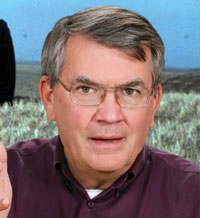
Guy Swanson
America’s farmers, with the benefit of subsidies and a more comfortable state of existence, didn’t need to rush to no-till the way the economically challenged South Americans had to. Exactrix’s Guy Swanson recalls the challenges domestically.
“Between 1969 and 1979, diesel fuel costs doubled and doubled again. The price started level for a decade in 1960 to 1969 at 25 cents per gallon, and by 1979, or 10 years later, diesel averaged 80 cents per gallon,” he says, noting that wheat prices also went from $1.80 to $6 per bushel due to the “Russian Grain Grab.”
He recalls that Greg Schick, during the Yielder No-Till Drill seminars, deployed pictures of an Arab sheik controlling the destiny of U.S. farming.
“His talks in the 1980s included the Arab Oil Embargo of the ’70s. He had a slide illustrating the death grip of the American agriculture economy by Saudi Arabia.”
Swanson notes that the fertilizer efficiency of the 1980 to 1989 with paired row hit a sweet spot, and nutrients seemed to be about 30-50% more efficient. Yet nutrients in the 1980s were not seen as significantly prohibitive to the budget. Instead, fuel was considered the monster of conventional farming because it really took another $40 per acre for tillage.
“Greg’s presentations often echoed in the meeting halls for hours after the presentation,” Swanson says. “At the cash bar, the discussion was about Big Oil. Every farmer knew his fuel bill could be cut 6 times with no-tillage. The savings for no-tillage was $40 per acre. The no-till candidates had focused on the problems of the environment and the economics of grain production. Established and new no-till farmers could confirm with operating statements that Big Oil had too much of an economic grip on agriculture across Canada and the U.S. Most no-tillers accepted much better economics by reducing diesel fuel use 4-6 times.”
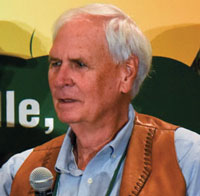
John Bradley
John Bradley, retired Univ. of Tennessee agronomist and No-Till Legend, saw an upswing in no-till when fuel doubled in the 1970s, but he also recalls that it quickly lost momentum as fuel prices stabilized, which remains a puzzle to him.
“Cost of tillage is one variable that farmers can control and reduce,” Bradley says. “They have no control over fertilizer prices, chemicals, seed, credit/interest and land rent.
“I was making trips to South America in the 1980s and 1990s when they were way ahead of the U.S. in no-till acres due to fuel cost, high interest rates and inflation. We have many farmers in the U.S. that farm for the ‘romance’ or lifestyle, rather than economics. I really don’t understand why we don’t see a wide swing toward more no-till in these economic times. It must be ‘farmer math’ rather than true economics.”
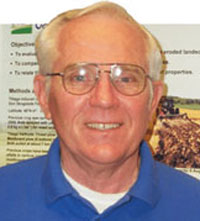
Don Reicosky
Don Reicosky, retired soil scientist who worked for the USDA-ARS, recalls his friend Bartz saying that the farmers in Latin America used the high cost of diesel as one of the reasons for going to no-till.
“His leadership and international travels make him an expert in that area,” Reicosky says. “At the same time, many of their erosion problems were very serious, and the increased costs of diesel fuel may have nudged them into action implementing no-tillage on the landscape.”
Like others, Reicosky notes that erosion attracted interest in no-till in the U.S., but he doesn’t recall diesel prices being leveraged as a primary driver 30-40 years ago.
“The Latin American farmers suggested crop subsidies reduced the risk for the U.S. farmers, and as a result it wasn’t absolutely essential to convert to no-till in the U.S.”
Now that erosion benefits are well accepted, Reicosky thinks many of today’s farmers realize they can reduce their input costs for diesel fuel by 40-60%.
“With the recent increase in the price of diesel, farmers should be considering switching to continuous no-till,” Reicosky says.
Much like how the underutilized automotive expert W. Edwards Deming and his ideas were embraced by the Japanese when the U.S. audience was inattentive, the likes of Phillips, Young and many others found a more receptive group in developing countries than at home.
“I recall conversations with several farmers from Argentina and Brazil who indicated that when they have their transportation infrastructure in place, they will put the U.S. soybean farmer out of business and outcompete them,” Reicosky adds.
Oil Crisis: A Blessing & Curse for Farmers, Allis-Chalmers
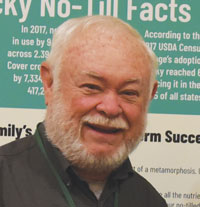
Tim Brannon
Tim Brannon, owner of B&G Equipment in Paris, Tenn., provided some thought to the question of the oil crisis and the impact on farmers. He recalls the heavy tube-type TVs of the early 1970s were either fixated on Pres. Nixon or the gas lines.
“Cars were backed up as far as the eye could see waiting for a ration of gas,” Brannon says.“ Somewhere across the ponds, leaders of oil producing nations that didn’t like the U.S. and Israel decided to punish us by withholding crude oil.
“Thank goodness we were in rural America. Prices at the pump spiked, but on the farm, we had plenty of diesel and gas in storage tanks to weather the storm.”
He recalls the fuel-guzzling days that preceded the oil crisis. “Annual planting consisted of moldboard plowing or chisel plowing, disking and then running the culti-mulcher in front of the planter. That was the 1960s; the advent of muscle tractors like D-21s , 5020s, 1155s and 1256s.”
Brannon, a former Allis-Chalmers (A-C) rep and a student of no-till history, cites America’s first commercial no-tiller, Kentucky’s Harry Young Jr., as the one who “changed our appetite for diesel fuel by truck loads forever.”
“We put the plows in the fence rows,” he says of the early years. “But we did not trade them in for the new no-till planters as we were not sure this much more efficient way of farming would work. The plows are still in the fence rows. In our neck of the woods, the turn to no-till or greatly reduced tillage, with the higher fuel prices and insecurity of supplies, was a blessing we mostly did not even recognize.”
Brannon recalls that his employer (A-C) boasted of a feature of its new fuel-saving tractor line. The revolutionary pressure/flow compensated hydraulic system gave closed center performance without the fuel burning costs. The sales pitches from the headquarters of efficiency really weren’t a selling feature.
“Most farmers bought a tractor and ‘turned the fuel to her’ anyway, negating any fuel saving over the Nebraska Tractor Tests that was supposed to be the ‘bible’ as to fuel usage to power produced.”
Higher petroleum costs resulted in higher fertilizer costs, which “hurt more than direct fuel costs in the next few years,” he says. “The fuel spike prices of the early 1970s was a sleeper in effect along with no-till practices. It made the small farms, which mostly went out of business in the 1980s, possible and possibly kept the wannabe, big-time operators in check, as fuel prices were a hindrance input factor. A farmer in the Mid-South could use a fuel efficient 80-hp tractor and farm 300 acres of a corn, wheat and soybean crop rotation, and stay on the farm or farm part time. Most had a livestock mix, and it proved a sustainable lifestyle until the aforementioned mid-1980s, when they either sold out or got bigger.”
While the first oil embargo was short-lived, Brannon recalls it hitting again in 1979. “Again, an angry revolution in an unstable part of the oil-producing world resulted in a shortage of petrol stateside. We watched a peanut farmer, President Jimmy Carter, in a sweater shivering in the White House telling us to turn down the thermostats and walk instead of driving our gas guzzlers. This oil shortage was a part of the ironic demise of A-C that built a lot of the first no-till planters and energy producing machinery.”
Allis-Chalmers’ Response. A-C was a multifaceted corporation that was back on its feet. It built flour-making equipment, sawmills, construction and mining equipment, farm equipment, generators, turbines for dams and even built the superchargers for the big bomber engines that helped win World War II. A-C ‘s innovation in technology produced the electric power generation from hydrogen that provided the system power in spacecraft to put astronauts on the moon. Then in the 1970s, A-C patented a process of producing gas from coal. It was reported that “The KILnGAS process, a coal gasification technology that was developed by Allis-Chalmers, is currently being demonstrated on a commercial scale at East Alton, Ill.”
The overstatement, says Brannon, represented a chink in the armor of Allis that led to its downfall.
“The man in the sweater appealed to the executives at A-C and with a pat on the back told him ‘You have the key to free us from dependence on foreign oil and those people who don’t like us.’ A-C, in patriotic duty, started pulling resources from all its divisions and put it into the coal gasification plant in Mt. Joliet, Ill. But it never produced a drop,” Brannon says.
The oil embargo was over, the peanut farmer went back to Plains, fracking was just over the horizon, and fuel was way below the cost of coal gas production possibilities. Rumors spread of A-C walking the halls of Congress, finding no friends to fund their production of which there was now no demand. Then the ag depression of the 1980s hit like a bomb, and A-C was no more. The shrapnel split the company into sellable divisions that survive today under different names, and in agriculture as AGCO.
The oil prices that spurred a change in agriculture and its efficiency was a blessing and a curse, depending on where one stood in the process that continues even to this day.
The 2024 No-Till History Series is supported by Calmer Corn Heads. For more historical content, including video and multimedia, visit No-TillFarmer.com/HistorySeries.


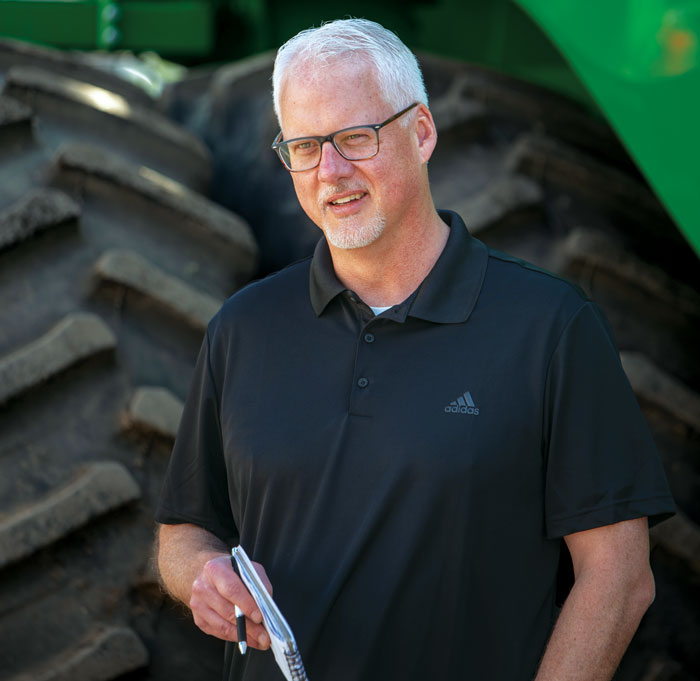





Post a comment
Report Abusive Comment